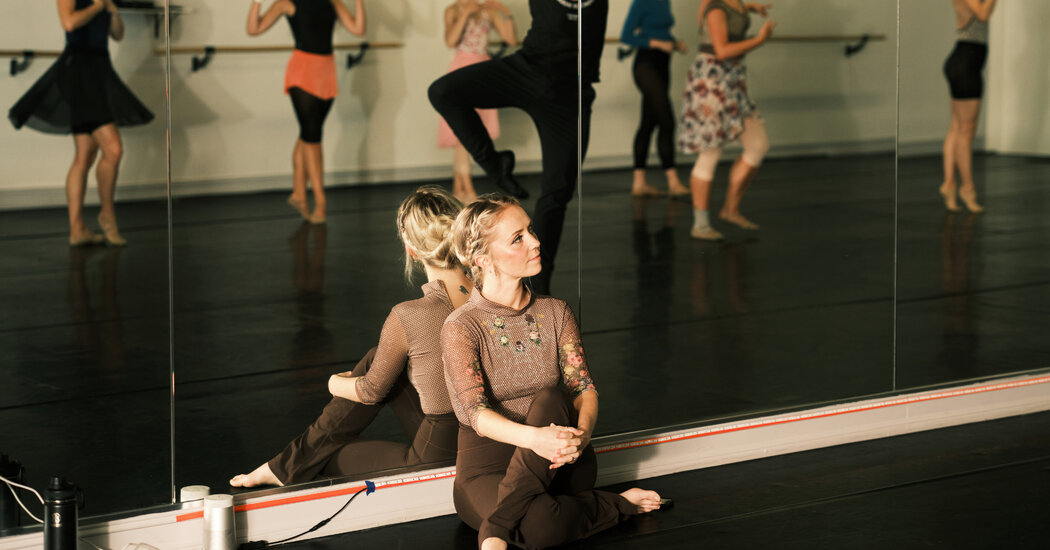At Azara Ballet, dancers aren’t expected to make eye contact with the directors and choreographers. If company members need an impromptu break from the harsh stage lights during rehearsal, they take one. They also receive clear directions about hair and makeup well in advance of performances.
The priority at Azara is dancers’ health. Founded in 2022 by the dancers Kate Flowers and Martin Roosaare, who are both autistic (and are a married couple), the company, which is based in Sarasota and Bradenton, Fla., is a haven for neurodivergent performers. (The company is made up of 10 dancers, not all of whom are neurodivergent.)
“When I am dancing,” Flowers said, “as long as it’s in a good environment and a safe space, the expression through nonverbal movement is something that helps me a lot.”
Azara addresses a gap in the dance world: the need for spaces where people who have autism, A.D.H.D. or other conditions that fall under the broad term “neurodivergent” can freely experience the art form. Evidence, both anecdotal and empirical, suggests that there’s a deep connection between dance and these neurological conditions. This relationship has become an area of increased focus for researchers, artists and performing arts organizations in recent years.
In November, Azara gathered for a run-through of its program “Voices of Azara” in the black box theater where the show would soon take place. The atmosphere in the theater felt both active — the dancers warmed up, reviewed steps, chatted — and calm: There was tempered lighting, pleasantly cool air and, among the performers, a seemingly innate awareness of the volume of their voices.
To begin the rehearsal, Roosaare gave the dancers a rundown of the schedule for the next three hours. Then, they went through the four pieces — all by company members — before receiving notes. As the dancers performed, the music was never overwhelmingly loud, and corrections were never shouted.
Mostly, though, the rehearsal didn’t appear much different than that of any small dance company. But what makes “a world of difference,” said the dancer Rebecca Kimsey, who is autistic, is the level of humanity and consideration in the studio.
“Martin and Kate have been very accepting and also very understanding of anything that comes up,” she said, “like if I’m having a day where I wake up with a migraine from overstimulation.”
She added: “If we’re in rehearsal and things are moving really fast, they still don’t yell out corrections, which can alarm or startle people if they’re focused.”
Flowers said she had always felt pulled toward dance. “Particularly with autism, it’s really helpful to have structure,” she said. “Dance really provides that. It makes sense why I was drawn to dance, and why I kept being drawn back.”
Research validates these experiences. Findings suggest that dance may be unusually well-suited to complementing the strengths that come with being autistic or having certain neurological conditions, while also assuaging some of the difficulties.
Dr. Jessica Eccles, a researcher at Brighton and Sussex Medical School in England, studies the way some conditions overlap with hypermobility (a larger-than-typical range of motion) and creativity. “Attention to detail, memory, passions, thinking outside of the box — all of these things probably are useful assets for dancers,” Eccles said. “A high proportion of dancers may well be neurodivergent, but it may not be recognized; they might not have diagnoses.”
Julia Basso, the director of Virginia Tech’s Embodied Brain Lab, has established further proof of the link between dance and neurodivergence, by measuring brain waves. Among a group of musical theater artists, most with autism, dance and performance were shown to increase intra-brain synchrony — that is, neural connections within a performer’s brain — as well as interbrain synchrony, or the connections made among multiple people. This suggests that dance can play an important role in things like social connection and decreasing anxiety, Basso said, which are common challenges.
Roosaare and Flowers have observed dance’s positive effects on a group of preschool-aged autistic students enrolled in Azara’s Atypical Dance Initiative. The students normally struggle to focus in school during the day, Roosaare said, “but when it comes to dance, they always pay attention and engage.”
While Azara takes a dancer-first approach to inclusivity, most companies primarily focus on audiences. New York City Ballet, for example, recently hosted a sensory-friendly performance of “The Nutcracker” and has another sensory-friendly event (a Balanchine triple bill) planned for May. Other companies have also implemented this practice, largely as part of the “Nutcracker” season.
“Audiences felt welcomed, they felt supported, they didn’t feel judged,” Meghan Gentile, City Ballet’s associate director of education, said about a sensory-friendly performance last spring. “More conversations are happening surrounding how to make all our performances a bit more accessible. There’s this new lens that’s been put on our work.”
At Azara all performances are conceived with neurodiversity in mind. A similar approach is being taken by Lumberyard Center for Film and the Performing Arts, in New York City, with its Seats on the Spectrum, an accessibility program designed for easy implementation at theaters. The pilot version, which debuted in October, is available at the New Victory Theater, the HERE Arts Center and at the Roundabout Theater Company.
Adrienne Willis, Lumberyard’s executive and artistic director, said that “while separate performances and the separate festivals are fantastic and they reach so many people, it’s not reaching an adequate number of the population.” She added that Lumberyard was interested in making accessibility “more economically viable for theaters.”
At many of these events, audience members are offered sensory kits — fidget toys, earplugs, noise-canceling headphones — and a visual and text-based description of what to expect from their time at the theater. There are often designated, less-crowded seating areas for neurodivergent viewers, and, during the show, house lights are never fully dimmed, lighting and sound effects are tempered, and patrons are welcome to come and go as needed.
These may seem like big changes. But the Azara dancer Kimsey said that when some of her friends attend these performances, “They’ve told me ‘I barely notice a difference; I didn’t know it was a sensory-friendly day.’”
Still, she added: “For those who need those changes, it is a lifeline. It connects you with something you could otherwise maybe never get to witness.”
The next generation of dance artists are developing the tools to consider neurodivergence, too. At the Glorya Kaufman School of Dance at the University of Southern California, Patrick Corbin, an associate professor of practice in dance, joined forces with a neuroscientist and occupational therapist, as well as neurodiverse theater performers, to establish a course called Dance and Neurodiversity/Autism.
By combining science, movement and community engagement, Corbin hopes the students will learn about how dance affects the brain and will also better understand these conditions as a whole.
“We develop strategies based in dance, using all of those things, to see how we can learn more about walking in somebody else’s shoes,” Corbin said. “Instead of trying to drag people with autism into our world, maybe if we went into their world we could find a bridge to connection.”
As Azara rehearses, it’s evident that connection is a goal. Each dance piece has a clear meaning or story, and the movements chosen by the choreographers are not too opaque to be understood, nor so literal that they feel hackneyed. The dancers move with certainty, with a sense of abandon and flow; they’re in their element.
“For me, choreographing helps in terms of expression,” Roosaare said, “to be able to portray certain feelings and emotions and ideas that are normally a little bit more challenging to get across to people.”
“I feel like there are a lot of undiagnosed autistic people in the dance world who have found it as an avenue of expression.”



